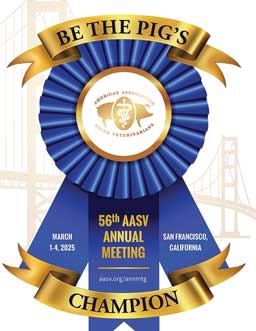You have probably noticed by now that the AASV executive officer team is sharing the responsibility to pen the President’s Messages in Dr Angela Baysinger’s absence. Dr Hollis called on us to be advocates, and Dr Robbins carried this theme further to discuss many of the rewarding formal and informal opportunities that arise to advocate within our practice and AASV activities. The objectives of advocacy and teaching are similar in that each seeks to provide knowledge that will change behavior. To achieve this behavioral change, the knowledge must be meaningful and compelling to the person you hope to influence or teach. As an organization, we have focused on evidence-based practice principles since our inception. Many of our membership fit the description of the “clinician-scientist” working to better understand animal health and welfare in real-time while managing cases. I remember my first AASV Annual Meeting and being impressed at the emphasis placed on systematic inquiry and the development and sharing of new knowledge with an evidence basis. Tangible examples of true, life-long learners were walking the halls and standing at the podiums of that meeting, and it was motivating. Certainly Dr Baysinger was an example of someone who worked to generate reliable new knowledge to improve the health and welfare of the pigs in our care using quality evidence-based approaches.
When building evidence, we begin with quality, systematic data that have as much bias removed as possible. These data are analyzed and summarized into information and then join the available body of information that becomes the evidence that supports a particular treatment or intervention. However, providing this evidence alone is not sufficient for teaching or advocacy. Additional components are required, especially when we are summarizing evidence as part of our message.
Trust is a critical component of teaching and advocacy. Merriam-Webster defines trust as “a firm belief in the character, ability, strength, or truth of someone or something.” If effective advocacy and teaching require evidence plus trust, then we are constantly advocating and teaching even when that is not the focus of the day’s activities. We must earn the trust of those we hope to influence by demonstrating our character, ability, strength, and truth consistently and constantly in our interactions with our peers and clients. As part of AASV executive committee meetings with organizations like the National Pork Board, the American Association of Veterinary Medical Colleges, and the American Veterinary Medical Association over the past year, it is clear that we are the trusted experts on swine health and welfare, especially in pork production settings. These groups also understand evidence-based approaches to medicine and can engage in discussions about topics of mutual interest at a very technical level.

Most of the targets of our teaching and advocacy efforts are not prepared to engage at a highly technical level. Things that strengthen trust are the effort to meet others at their level of understanding and listening to what is important to them. Common ground is a great position from which to advocate. Dr Baysinger understood these things and lived them. She earned trust as an advocate because she was engaged in what she was talking about every day.
While we are talking about teaching and advocacy, it is important to reflect on whom we, as an organization, represent. When you review historical meeting agendas, the practice activities of our membership, and the statements that we make as an organization, we are clearly focused on production medicine practiced on animals that are destined for the human food supply. When you consider that the overwhelming majority of pigs in the world are raised for this purpose, and their health has a very direct impact on most of the human population, this makes sense and should continue.
I would argue that the relatively recent increase in pigs being used for other purposes such as biomedical research, pets, and competitive show animals means there are some additional areas that we need to include if we expect to be the exclusive advocates for swine medicine. Estimates vary significantly but suggest that there are at least 1,000,000 households with a pet pig and about 100,000 sows producing show pigs. If you consider that most of the show pig producers are more like each other, in terms of production characteristics and health challenges, than they are to any other system, they would have been the 11th or 12th largest production system in the United States in 2023.
As current chair of the Program Planning Committee preparing for the next AASV Annual Meeting, I have spent a lot of time seeking out and talking to veterinarians that practice swine medicine, but are not members of our organization, to better understand how we as an association might meet their needs. You will see the results of these conversations reflected in the agenda of the 2025 Annual Meeting in San Fransisco. Why dedicate part of our valuable meeting time to topics pertinent to biomedical, show, and pet pigs? Because AASV should be the trusted advocates for all pigs, everywhere. Trust is critical in effective advocacy and trust develops from demonstrating our character, ability, strength, and truth consistently and constantly. This means we need to engage these areas of practice and groups of clients. There is nothing about a pig’s role or use in society that should interfere with providing the highest quality of health and welfare while they are alive and in our care.
See you in San Fransisco when we remind folks that we are the pig’s champion – all pigs, everywhere.
Locke Karriker, DVM, MSc, DACVPM
AASV President-Elect